- Home
- Aaron Allston
Terminator 3--Terminator Hunt Page 28
Terminator 3--Terminator Hunt Read online
Page 28
“That is true,” Glitch said. “The prime goal of the mission is accomplished. But there is still the distant likelihood of component failure on your part.”
“That component being my sanity?”
“Use of that word constitutes an oversimplification in this situation.”
Paul put the truck into gear. He backed out of its parking space and aimed it in the direction the exit signs indicated. It shuddered as it climbed through first gear into second.
The concrete ramp led them up and to the right. Past the bend, Paul could see, above, that the ramp apparently leveled off. Beyond was the grating Mark had described.
Bright, moving lights shone outside it.
“We’re in for trouble,” Paul said. He pulled his safety belt around him and buckled it.
He was in third gear when he topped the ramp and hit the grating. His truck blasted out into the street in front of the hotel. The grating, still in a single piece, flew out into the street ahead.
To his right, through Glitch’s open window, Paul could see a large twin-rotor helicopter hovering mere feet above the ground, its tail end a mere twenty yards away. Assault robots streamed out of its passenger bay door, entering the hotel at a dead run. The last dozen or so turned to look at Paul’s truck.
Paul wrenched the truck into a leftward turn, grimaced as he felt the left row of wheels leave the ground. Then they came back down with a bang. He mashed the accelerator.
In the rearview mirror, assault robots ran after them on foot. The Jeep roared out through the now-unobstructed exit and turned in his wake. Then came the hotel shuttle.
Paul made an immediate right turn onto the next street. He heard assault rifle fire open up, heard the sides of his truck hammered by plasma hits.
The Jeep didn’t follow; it roared along the street in front of the hotel and was almost instantly lost to sight. The hotel shuttle did follow, and in the rearview mirror Paul could see an assault robot riding atop it, its arm already thrust through the roof, grabbing at whatever was within. More robots ran along in the Jeep’s wake.
A stream of plasma shots from inside the shuttle took that robot in the face and chest, hurling it off the rear of the vehicle. More assault robots, on foot, now farther back, rounded the corner. Some stopped running and raised their rifles.
Paul took the next left turn. He had to break up his pursuers’ line of sight. The shuttle, more nimble, sideslipped a little and the first rounds of plasma damage missed it, slamming into the rear of Paul’s truck. Then he was around the corner, the shuttle immediately behind him.
The shuttle roared around him to the left. In the front passenger seat, Ten offered him a little salute. Paul could stare down through the hole at the rear of the roof, could see Eliza’s eyes on him. Then the shuttle was past, accelerating.
“Okay,” Paul said, “this sucks. The enemy has seen us, they’re here in force, they have a vehicle with mobility superior to ours, and they’re kind of hostile.”
“What do you recommend?” Glitch asked.
“We let the plan proceed. Once they lose direct line of sight on everybody, they’ll revert to their programming. And if we’re right, they’ll get a fix on Eliza’s signal, which is being carried by the Scalpers, and follow it. Putting us in the clear, hopefully for long enough.”
The shuttle continued to accelerate, leaving the truck farther behind. Ahead, it took a right turn.
“Is that south?” Paul asked.
“That is northwest.”
“Not good.” He turned to follow. “Why northwest?”
“There is a high probability that they are doubling back to reach the interstate highway.”
“Are we going to hear the hotel blow up?”
“The explosion will be insufficient. We did not have access to a substantial amount of evaporated fuel. The hotel will probably not collapse and we will probably not hear it. But the operating theater and surrounding rooms will be destroyed.”
“Too bad.”
Then Paul’s eyes were dazzled as the shuttle ahead was bathed in a powerful searchlight from above. Paul craned his neck to see. The transport helicopter was above, about halfway between the two vehicles. Paul hammered on the steering wheel. “Dammit.”
“Earl Duncan will bring it down with an RPG.”
But the helicopter dropped back, until it was over Paul’s truck.
Ahead, the shuttle took a right turn.
Paul hesitated for just a second. If for some reason the helicopter were locked onto him or Glitch, separating from the shuttle now would give the Hell-Hounds a better chance of getting out of sight.
He turned left.
The helicopter followed him.
“They’re after us,” Paul said. “Why?”
There were several thumps from the roof of the main body of the truck. Paul could imagine, could almost see assault robots raining out of the helicopter, two or three of them, to land atop his vehicle. “Forget I asked. Maybe,” he suggested, “you ought to go up and deal with that.”
“Yes,” Glitch said. He kicked at his door, effortlessly knocking it free from its hinges, then climbed up onto the roof of the cab.
c.22
Above and behind, the helicopter followed them. Glitch could see its pilot, an assault robot, through its forward windshield. The robot stared at him with the pitiless angular features the humans so hated.
The instant Glitch stood up from the lower cab roof to peer over the back of the truck, the two assault robots moving forward on that dented surface opened fire on him.
He ducked, his tactile sensors indicating that high-temperature projectiles, doubtless plasma, had just missed his back by inches. The odds that his clothing and the artificially grown skin beneath it were charred, even on fire, were very high.
He calculated his tactics. His two opponents were inferior to him in combat abilities and processing power but had the advantage of numbers and possessed superior weapons.
The truck veered left, a sharp enough turn to cause the truck to angle and tilt again. Its left side crashed down with an audible bang. Glitch glanced in their original direction of travel, noted that further progress along that path would have put them over the curb, across a set of railroad tracks, and into a river channel. Perhaps the sudden maneuver was indeed the best course of action.
He peered over the top again. There was now only one assault robot atop the truck, and it was struggling into a sitting position.
Glitch leaped at it. He saw the assault robot bring its plasma rifle to bear, begin to squeeze the trigger … then he crashed down upon it.
Together, they ripped through the frail metal membrane that served as the truck’s roof and crashed down into the empty area within. The impact drove the assault robot halfway through the floor, wedging it into that surface.
Glitch got one hand on its plasma rifle, turning its barrel away from him. The robot managed to lash out, kicking Glitch away. Glitch landed with half the rifle in his hand.
The assault robot aimed what was left of the weapon, glanced at it, dropped it. The robot heaved itself free of the hole in the floor and advanced on Glitch.
Glitch rose and hurled himself at his enemy once more. They came together in the middle of the cargo bed, grabbing, hammering at one another.
Glitch got a grip on his enemy, braced himself to swing the robot into or through the side wall. But the act of bracing himself against that much weight, that much power, drove his foot through the floor. He sank with a sudden thump up to his crotch, felt his foot hit the pavement below.
The assault robot backed away, its head cocked, considering the best way to terminate its enemy. Then it bounced up as the truck bed suddenly vibrated.
This was no routine change in road conditions. Glitch’s tactile sensors detected major alterations in the grade of the road below. He yanked his foot up and away from the surface to prevent damage to his limb. He gripped the sides of the hole that held him, both to keep from being rattl
ed around and to widen the gap, freeing his leg.
The assault robot’s gyroscopic compensators did their best to maintain its balance. Then the front end of the truck slewed to the left and the world turned upside down.
Working with very limited visual data from light streaming in through the holes in the sides and floor, Glitch decided that the truck was falling onto its side. His analysis subroutines popped up the various likelihoods that it would roll or merely skid along its right side.
Against the odds, it rolled.
* * *
The instant Glitch disappeared onto the roof, Paul returned to thinking about what was going on.
The helicopter was pursuing him or Glitch.
Had he failed to give both tracking devices to Sato? No, he remembered them both being in his hand when he passed them over.
Could they have sensors that locked onto Glitch’s electromagnetic emissions, discerning how his were different from those of other machines? If so, such technology was new. Otherwise, they’d have used it to track Glitch as he left the ruins of the San Diego Naval Medical Center.
Which meant that the odds were they were tracking him, Paul. Tracking the radio emissions from the implant in his head.
The road did not continue ahead. There were train tracks in that direction, gleaming dully in the moonlight. At the next street, Paul took his only available option: a hard left turn.
After Santa Fe, they’d figured out the trick with the T-X’s tracer. They weren’t going to follow these tracers. They must be assuming the tracers were attached to another coyote. No, their assumption was that wherever Paul was, there the T-X would be as well.
That wasn’t so bad. The longer he could remain at liberty, the longer his friends had to get away.
There were bangs and crashes from the bed of the truck. Glitch was putting up a fight.
The last turn had reduced the truck’s speed. Paul started to mash the accelerator again, then thought better of it.
He let the truck slow, moving forward solely on momentum, as he unbuckled himself, then pulled his backpack straps around him and grabbed up his rifle case.
When the speedometer read that they were down to a good running speed, he threw the door open and jumped out.
His feet hit the pavement and he fell, stumbling forward, to crash onto the street. But the impact didn’t hurt too much; he felt warmth on his palm, sure sign that it had been skinned, but there was no significant pain.
The helicopter followed the truck for a few dozen yards. It slowed, letting that vehicle bounce on ahead. Paul saw the truck’s wheels bounce over the curb. Then he rose and ran.
He took the next street to the right. The helicopter pursued him, but its weapons, if any, did not fire. No assault robot troops came tumbling out of it.
The street became a bridge, first crossing over railroad sidings, then over a broad stream. On the other side were older buildings. The long-dead signs on them, many still readable in the moonlight, advertised restaurants, nicknack shops, candy stores.
He stopped at the first cross-street. The helicopter hovered over him, blasting its searchlight down upon him.
He drew his handgun and shot the spotlight. It blinked out, leaving him in darkness.
The helicopter gained a little altitude. As it did, Paul unzipped his rifle case and pulled out the sniper rifle. As the helicopter banked away, he aimed at the point where the forward rotor mechanism rose from the fuselage.
His first shot did not hit it. His third did. The front end of the helicopter, heading away from him, began an abrupt plummet. The rear rotor continued driving up and forward.
The helicopter came down atop a two-story building that had once been home to restaurants and souvenir shops. It deformed as it hit.
Paul turned his back on the crash. It had bought him some time, perhaps only a few seconds, in which he wasn’t under observation. He couldn’t waste what he had.
He trained the rifle on the nearest manhole cover and pulled the trigger. There was an almighty flash of light and he watched the superheated circle of metal pop up into the air, spinning like a flipped coin, and land yards away.
He dashed over to the manhole and clambered down.
* * *
As the truck finished its roll and came to a stop, Glitch let go of the edges of the hole his leg had made. He dropped straight onto the assault robot, driving its head into what had been the roof, then slammed the robot forward, shoving its head and shoulders through the sheet metal wall of the truck.
The robot’s hand closed over his face. Fingers dug into his optical sockets. He shook his head, dislodging them, and grabbed the robot beneath the armored ridge that would have been the ribcage of a human. Then he got his feet braced on its pelvis … and heaved.
The robot jerked and flexed to throw him off. Doubtless its diagnostic registers were lighting up. Glitch simply increased the pressure he was exerting.
He was rewarded moments later with a pang! as armor welds gave way. The entire front piece of the robot’s torso armor came off in Glitch’s hands.
The robot sat up, yanking its head free of the truck wall.
With a sudden, savage motion, Glitch folded the armor plate in half. Then he put it back approximately where it belonged, burying it to a depth of ten inches in the robot’s unprotected chest.
The robot lay down again. Sparks sizzled up from its ruined torso.
Opportunistic, Glitch quickly disengaged the hydrogen cell that powered the robot. An assault robot carried only one of these, instead of the two an advanced machine like Glitch carried, but the designs were compatible. Glitch pocketed the device and walked out through the truck’s side, splitting the metal there as though it were foil.
He moved to the upside-down cab. It was empty.
He scanned the skies. There was IR evidence of a growing fire a few blocks away, and heat traces appropriate for smaller airborne vehicles, probably H-Ks, in distance to the north. But there were no enemies in close range. Nor could he see Paul.
He was alone.
* * *
Infrared goggles in place, Paul moved as quickly as he dared through the storm drains of the city. He had no idea what direction he was taking; a few bends and turns, and he’d lost his bearings entirely.
But that was all right. His goal was to confuse and mislead the enemy, not find his way home.
He reached a point where moonlight shone in through a drain opening up to a street gutter. He waited there, listening, for long minutes.
Finally he heard it: the roar of an engine. Brakes squealed nearby and he could hear metal feet striking the pavement.
He ran again, looking for a side shaft that would carry him away from this streetside channel, and found one.
When he went deep enough, earth and concrete made it impossible for his pursuers to detect his weak radio transmissions. When he found a surface access, they began receiving him again and would race to that spot.
He found himself in a channel that seemed to go on forever. It was another streetside stretch of storm drain. Every few dozen steps, he passed a gutter opening up to the street. Even more occasionally he spotted a shaft and metal ladder that led up to a manhole. He encountered no side shafts large enough to accommodate him.
In the distance far behind him he heard dull clanking. It was like the fast rattle of a big, badly maintained engine … or the passage of many metal feet. And as consistent as the sound was, it had to be originating back in this drain.
But it wasn’t growing louder. He thought he was maintaining his lead on those presumed pursuers—or even increasing it.
Ahead was an area of brightness. He headed toward it, cautious. It seemed to stretch from floor to ceiling.
Then he saw boots descending from the ceiling. Boots, stout legs, a stout body.
A Terminator. As it came to rest and turned in his direction, he could see its features. It was not Glitch; it had another face, one he didn’t recognize.
Which
meant it was probably an 800 and belonged to a subseries he wasn’t familiar with.
He froze, breathing hard, thinking harder.
That Terminator had probably seen him, at least as a distant heat source. The attack robots coming up from behind, as far away as they were, would still be able to see his glowing footprints. The presence of the Terminator explained why they weren’t hurrying.
They had him trapped between them.
He was dead.
* * *
The Jeep Cherokee roared eastward until the road reached the I-25 on ramp. At Sato’s gesture, Jenna pulled over to the side of the road and let the engine idle.
Sato stuck his head out the passenger-side window and scanned the skies. “Still no pursuit,” he said.
Jenna sighed. “We’ve screwed up. But in a few minutes, they’ll have a lot more resources in the sky, and they’re sure to dedicate some of them to us.”
“You’re right.” Sato shook his head. “The others are on their own.” He fished the two T-X tracer transmitters from his pocket and gave them one last look. Then he flicked them off into the darkness for Skynet’s forces to find. “North.”
“You got it, boss.”
* * *
Kyla trotted through the trees of the neglected, overgrown parkland until she reached water’s edge. She breathed a sigh of relief. This was not yet another runoff canal of the Arkansas River, but a reservoir or smallish lake, perhaps half a mile across. To her left its banks wandered to the east; to her right, they curved around to a more southerly orientation. She followed the banks around to the right, knowing that the others would find her.
The only question was: Would she find what was supposed to be waiting for them?
Then, up ahead, she saw it above the trees, the most minute of variations in the greenish darkness of the sky. This patch of heat was just enough brighter for her to detect the difference. It was also nearly perfectly circular, meaning she had to be looking straight on at the blimp’s nose or tail. She hurried on.
Then she was beneath the blimp’s leading edge and could no longer see stars through the trees. She raised a hand to wave at the unseen sensor ball and paced off another forty steps. Then she waved up at the gondola again, a “Come on down” sort of gesture.

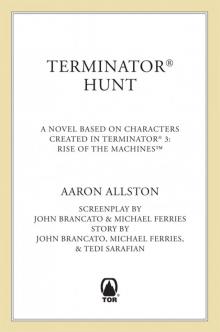 Terminator 3--Terminator Hunt
Terminator 3--Terminator Hunt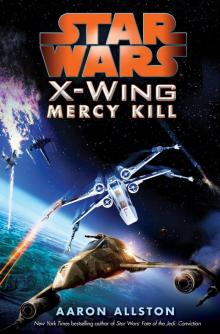 Mercy Kil
Mercy Kil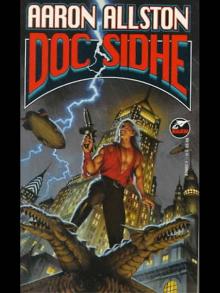 Doc Sidhe
Doc Sidhe Star Wars: Fate of the Jedi: Outcast
Star Wars: Fate of the Jedi: Outcast Fate of the Jedi: Backlash
Fate of the Jedi: Backlash Mercy Kill
Mercy Kill Rebel Stand
Rebel Stand Wraith Squadron
Wraith Squadron Star Wars: X-Wing VII: Solo Command
Star Wars: X-Wing VII: Solo Command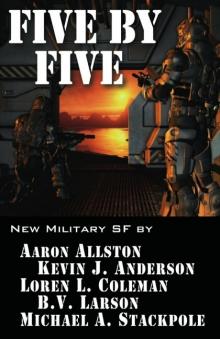 Five by Five
Five by Five Solo Command
Solo Command Star Wars: The Clone Wars Short Stories: The League of Spies
Star Wars: The Clone Wars Short Stories: The League of Spies Sidhe-Devil
Sidhe-Devil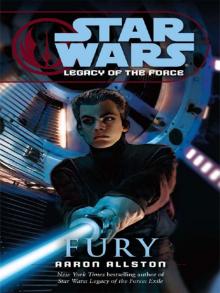 Star Wars: Legacy of the Force: Fury
Star Wars: Legacy of the Force: Fury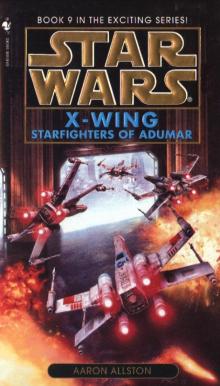 Starfighters of Adumar
Starfighters of Adumar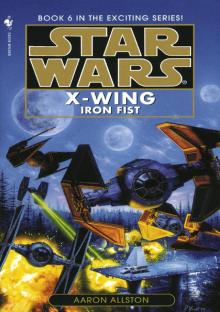 Star Wars: X-Wing VI: Iron Fist
Star Wars: X-Wing VI: Iron Fist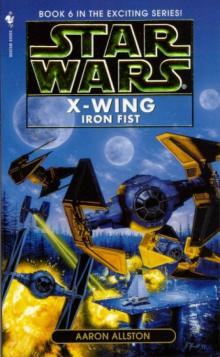 Star Wars - X-Wing - Iron Fist
Star Wars - X-Wing - Iron Fist Exile
Exile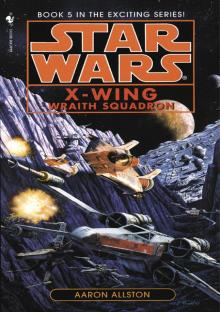 Star Wars: X-Wing V: Wraith Squadron
Star Wars: X-Wing V: Wraith Squadron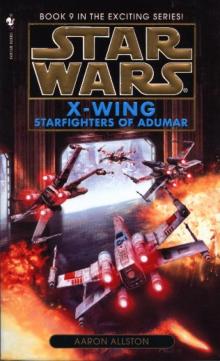 Star Wars - X-Wing - Starfighters of Adumar
Star Wars - X-Wing - Starfighters of Adumar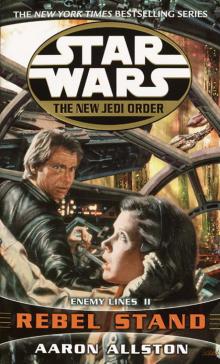 Rebel Stand: Enemy Lines II
Rebel Stand: Enemy Lines II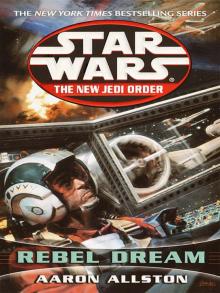 Rebel Dream: Enemy Lines I
Rebel Dream: Enemy Lines I Outcast
Outcast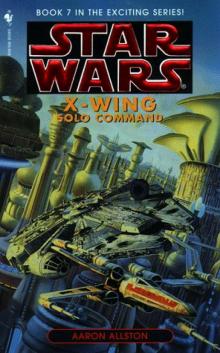 Star Wars - X-Wing 07 - Solo Command
Star Wars - X-Wing 07 - Solo Command